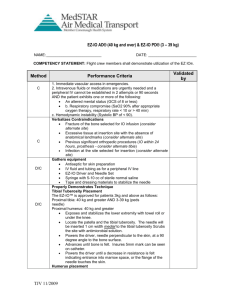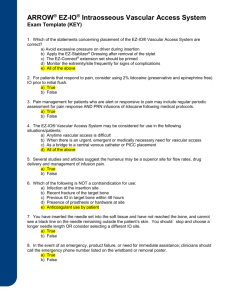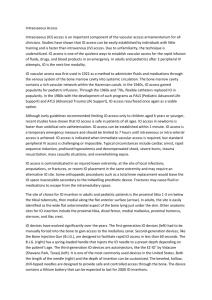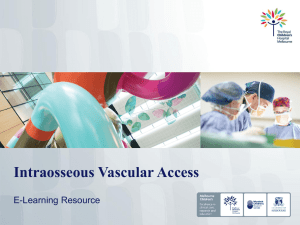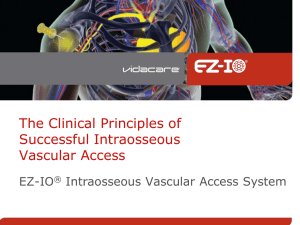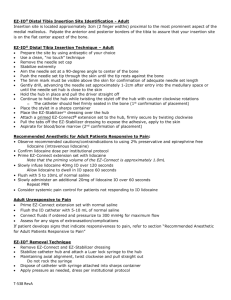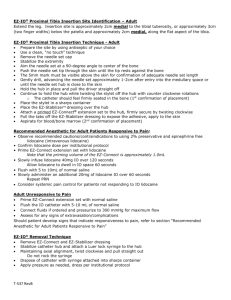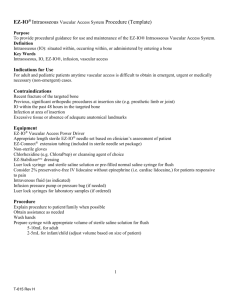EZ-IO Needle Set - Verde Valley Emergency Medical Services
advertisement
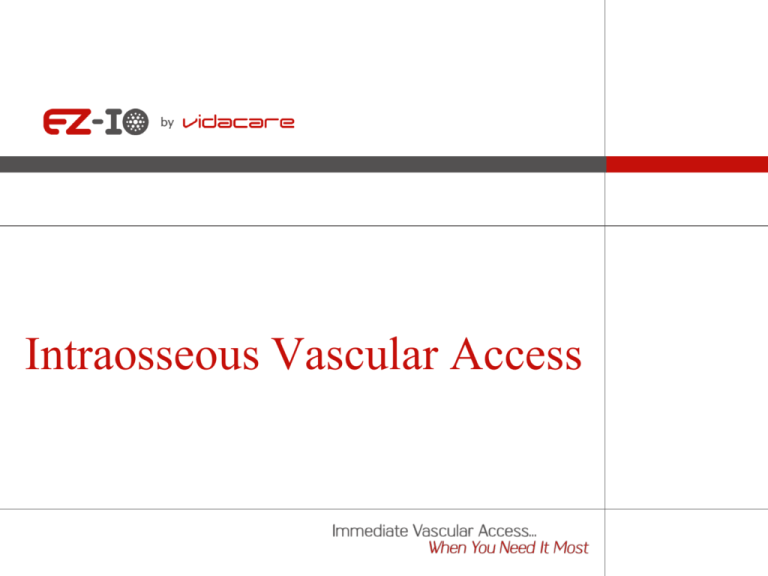
Intraosseous Vascular Access The System EZ-IO Training Materials PowerPoint™ Presentations With comprehensive notes located behind each slide EZ-IO StarCast Presentations Quick Reference Card Insertion & Removal Poster Training Mannequins Training Driver & Needle Sets Complete Web Site Clinical Support Hotline The EZ-IO Lithium Driver Lithium Batteries Designed for 1000 human insertions Sealed cap Needle set packaging The EZ-IO Needle Sets Specialized tip EZ-IO Needle Set (safety cap removed) EZ-IO Needle Set (“X-Ray View” with safety cap) Stylet Catheter &Hub Stylet Needle Set Safety Cap Catheter & Catheter Hub Stylet Metal Disc EZ-IO PD & EZ-IO AD needle sets 15 mm in length 25 mm in length 5 mm mark Length and color are the only differences between PD & AD needle sets Sealed Sterile Cartridge Open Cartridge Note: “lot code and expiration” moved to cartridge barrel Note: Needle Set’s position Note: torn (and lifted) safety seal Open Cartridge Note: exposed “single use only” sticker Open Cartridge Note: torn (and lifted) safety seal Stylet in “Shuttle” Stylet in “Shuttle” Note: REMOVED safety seal Note: REMOVED safety seal Put it where it belongs! Stylets belong in approved sharps containers Consider these points BEFORE EVERY EZ-IO insertion: 1. Did you “hear” a pop when the cartridge was opened? 2. Did the Driver easily attach to the Needle Set (With the Needle Set remaining in the cartridge)? 3. Needle Set Did you REMOVE the Needle Set Safety Cap from the Needle Set? 4. Did you CONFIRM the 5 mm mark? Note that a “lone Stylet” sits deeper than a complete Needle Set Important EZ-IO usage considerations Precise cylindrical hole created by EZ-IO insertion The EZ-IO Infusion Solution EZ-IO Storage Cases & Cradle EZ-Connect EZ-IO Driver Training Driver Wristband EZ-IO AD & PD Needle Sets Training Needle Sets General IO Anatomy Anatomy of intraosseous access Thousands of small veins lead from the medullary space to the central circulation Adult IO Anatomy Proximal Tibial Anatomy Distal Tibial Anatomy The ankle joint is comprised of the Tibia, Talus and Fibula Proximal Humeral Anatomy The Proximal Humerus insertion site is found “slightly anterior to the arms lateral midline” Right arm Adult male Note that arm is adducted with the elbow posteriorly placed! Pediatric IO Anatomy If the patient “fits” on the Broselow™ Tape THINK PINK* and use the EZ-IO PD = *Obese pediatric patients may require the EZ-IO AD needle Set Pediatric Anatomical Overview The pediatric growth plate Clearly visible tibial growth plate Tibia Right Leg Left Leg Identifying the EZ-IO PD insertion site If the Tibial Tuberosity CANNOT be palpated the insertion site is two finger widths below the Patella (and then) medial along the flat aspect of the Tibia The Tibial Tuberosity can be difficult or impossible to palpate on younger patients Identifying the EZ-IO PD insertion site If the Tibial Tuberosity CAN be palpated the insertion site is one finger width below the Tuberosity (and then) medial along the flat aspect of the Tibia As patients mature the Tibial Tuberosity becomes easier to identify Indications Indications for intraosseous access Cardiac Arrest Respiratory Compromise Need for immediate rapid sequence induction Hemodynamic Instability Mass Casualty Situations Trauma Resuscitations Bridge to Central Line Allowing Controlled Placement Altered Level of Consciousness Difficult IV Placement Intraosseous Access = Immediate Vascular Access Indications for Intraosseous Access Patients with poor peripheral access •Dialysis Patients •Sickle Cell Patients •Obese Patients •Mass casualty incidents (shootings, motor vehicle collisions) •Congestive Heart Failure •Oncology Patients •IV Drug Abuse •Dehydration (especially pediatrics) •Diabetic Patient (DKA or hypoglycemia) Consistent with the AHA & ERC Guidelines Intraosseous Access = Immediate Vascular Access AHA, ERC, ILCOR, NAEMSP Guidelines IO should be considered early in vascular access emergencies • Adults - 2 peripheral IV attempts Progress to IO • Pediatrics - 1st line of choice ET tube is no longer recommended for drug delivery Central lines are discouraged • Approximately 5 million central venous catheters placed each year in US • Central line placement causes unnecessary drug delivery delay during resuscitation • CDC report indicates 9% infection rate with central lines in US ILCOR is comprised of seven formal members – American Hear Association, European Resuscitation Council, Heart and Stroke Foundation of Canada, Australian and New Zealand Committees on Resuscitation, Resuscitation Councils of Southern Africa, and the InterAmerican Heart Foundation and Resuscitation Council of Asia What About Infections With IO 20 + year history in pediatrics with Cook/Jamshidi needles sets • Overall infection rate is 0.6% • Cases of osteomylitis occurred when catheter was left in place for > 72 hours • Newer IO devices cause less bone trauma EZ-IO database • Contains 2000+ insertions with no local infections or osteomylitis • Estimate of 80,000+ insertions with no local infections or osteomylitis Intraosseous access: is it painful? IO insertion pain is equivalent to a peripheral IV IO infusion pain can be severe but is significantly moderated by the administration of 20 – 40 mg Lidocaine for patients > 39kgs and 0.5mg/kg for patients 39kgs or less via the IO route (*2% preservative free Lidocaine is recommended) Pressure and Flow Rates With pressure, IO flow rates are similar to IV • Tibial relates to a 18 gauge catheter • Humeral relates to a 16 gauge catheter Flow rates for infusions given through an IO with a 300 mm pressure infuser • 3 – 6 liters/hour of saline • Unit of blood in approximately 15 - 30 minutes Syringe bolus infusions can be completed in seconds Initial rapid 10 cc syringe bolus for patients > 39kgs and 5cc flush for patients 39kgs or less dramatically increases IO flow rates NO FLUSH = NO FLOW Infusion of Medication Which Drugs can be given? • Any medications that can be safely injected into a central venous catheter can be safely injected IO What Dose? • IO and IV doses are identical Lab Testing: • 10 - 15 cc of blood can be aspirated from an IO device and placed into a syringe for standard laboratory testing The Reality of Intraosseous Flow Immediate flow from the tibia and proximal humerus to the central circulation Contraindications • Local Infection (at the insertion site) • Fractures (to the bone selected for insertion) • Prosthesis • Recent (24 hours) IO in same extremity • Absence of anatomical landmarks or excessive tissue EZ-IO Access The art of insertion Observe Body Substance Isolation Precautions Adult Confirm and clean insertion site Confirm and clean insertion site Identify the Proximal Humerus insertion site Elbow should remain adducted and posteriorly located Place the hand over the umbilicus for humeral positioning and safety orient the arm to this position Preferred insertion site identification method Place patient in supine position with the arm correctly oriented Coracoid Process This alternate method of identification can be used in association with the preferred method to ensure proper placement Alternate site identification method Acromion Confirm and clean insertion site Pediatric Confirm and clean insertion site Confirm and clean insertion site Confirm and clean insertion site Insert AD needle set into appropriate site Position the EZ-IO Driver at a 90 degree angle to the bone Remember “EZ does it” Lightly holding the EZ-IO driver will improve usage 40 kg and greater usage Don’t force the needle set into position - “allow the driver to do the work” Insert PD needle set into appropriate site Position the EZ-IO Driver at a 90 degree angle to the bone Lightly holding the EZ-IO driver will improve usage 3 - 39 kg usage Select needle set based on patient size & weight Important needle set insertion tip Allow driver to do the work! DO NOT EXCESSIVE FORCE Gently GUIDE needle set into position 3 - 39 kg usage 40 kg and greater usage STOP WHEN YOU FEEL THE POP User induced recoil may lead to needle set dislodgement or extravasation Remove stylet and confirm placement Confirm placement by noting • Blood at the stylet tip • Firmly seated catheter • Blood in the catheter hub • Aspiration of blood • Fluids flow without difficulty • Pharmacologic effects Monitor the insertion site and distal extremity for signs of extravasation Syringe flush catheter No Flush = No Flow Syringe flush the catheter with 10 ml (5 ml for PD) of a sterile solution Avoid rocking the EZ-IO catheter during usage Use the EZ-Connect supplied with the needle set! Begin infusion with pressure 3 - 39 kg usage Regulate fluid delivery for pediatric patients 40 kg and greater usage A pressure bag, infusion pump or syringe will improve the flow rates EZ-IO Removal Maintain a 90 degree angle Maintain 90 degree angle, Rotate clockwise and gently Pull Once catheter has been removed – cover site and monitor patient Possible Complications Rocking, Bending or inadvertently Striking the catheter may cause it to break If breakage occurs Grasp the exposed catheter with a hemostat – rotate and pull 24 hour emergency support 1.800.680.4911 Around the world - 24 hours a day, 7 days a week Questions?
